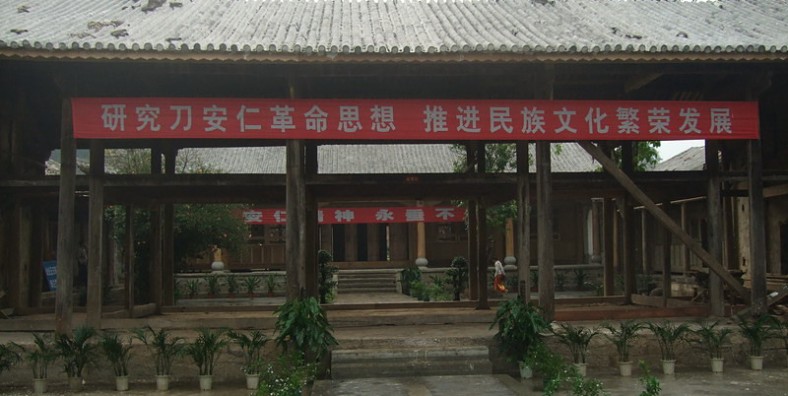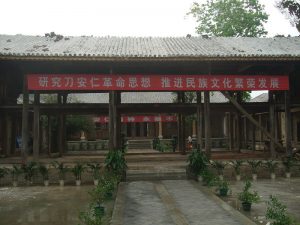The Former Residence of Dao Anren in Yingjiang County, Dehong

Attraction Overview
The former residence of Dao Anren is located in Xincheng Township, Yingjiang County, Dehong Dai and Jingpo Autonomous Prefecture, Yunnan Province, 30 kilometers from the county seat. It is home to an imposing mansion built in the Kangxi period of the Qing Dynasty. It is a civil building structure. This is the former residence of Dao Anren, the great man in the frontier. Like Dao Anren’s ups and downs, this building has weathered in the long river of history.
Chinese Name: 盈江县刀安仁故居(Pinyin: Yingjiang Xian Dao Anren Guju)
English Name: The Former Residence of Dao Anren in Yingjiang County, Dehong
Attraction Type: Historical site, building
Best Time to Visit: All year round
Recommended Visiting Time: 1 hour
Opening Hours: All day long
Admission Fee: Free
Address: 30 kilometers from the county seat, Xincheng Township, Yingjiang County, Dehong Dai and Jingpo Autonomous Prefecture, Yunnan Province, (云南省德宏傣族景颇族自治州盈江县新城乡,距离县城30公里)
🌟 Historical Significance
Dual Identity
The residence serves two intertwined roles:
-
The former office of the Ganai Native Official (Tusi) system during the Qing Dynasty
-
The birthplace and revolutionary base of Dao Anren, a pioneering ethnic Dai leader and anti-imperialist figure
Revolutionary Milestones
-
In 1906, this site became the Ganai Branch of the Tongmenghui (Chinese Revolutionary Alliance)
-
By 1911, it was the command center for the Western Yunnan Uprising, which helped spark the Xinhai Revolution in this frontier region
🏛 Architectural Features
Spatial Layout
Covering 22,300 square meters, the original complex followed a traditional four-hall courtyard design (Si Jin Si Tang). Key features include:
-
Main Hall (residence of the Tusi / native chieftain)
-
First Hall (courtroom)
-
Second Hall (assembly chamber)
-
Third Hall (offices for aristocrats)
Flanking corridors and auxiliary rooms once completed the compound.
Restoration Highlights
In 2008, the Main Hall was reconstructed using catalpa and black-heart wood, with a copper-tile roof. The traditional lattice windows and door frames were meticulously preserved, echoing local architectural elegance.
📜 Dao Anren: Life & Legacy
Brief Biography (1872–1913)
-
Anti-Colonial Commander
At age 19, Dao Anren became the Ganai Native Official and led an 8-year resistance against British forces at Tiebiguan Pass. -
Revolutionary Vanguard
In 1906, he traveled to Japan and joined the Tongmenghui under Dr. Sun Yat-sen, pledging his wealth to the national cause. -
Pioneer of Industrial Reform
He introduced 8,000 rubber tree seedlings from Singapore, initiating Yunnan’s first rubber plantation on Phoenix Mountain. -
Honored Posthumously
Praised by Sun Yat-sen as a “Hero of the Frontier, Elite of China,” he was posthumously awarded the title of General.
🖼 Exhibits & Memorials
Heritage Museum
The on-site memorial hall houses classified national relics (Level II and III), including personal artifacts and revolutionary documents. Exhibits also trace the evolution of the Tusi administrative system in southwest China.
Cultural Symbolism
At the heart of the courtyard stands a bronze statue of Dao Anren, whose pedestal is engraved with a dedication by Sun Yat-sen — a powerful homage to his patriotism.
📌 Visitor Information
| Item | Details |
|---|---|
| Opening Hours | Open year-round (check locally for specific times) |
| Admission | Free entry (as of 2025 policy) |
| Navigation | Search for “刀安仁故居 (Dao Anren Former Residence)” — about 40 minutes’ drive from Yingjiang County (Xinzheng Township); free parking available |
| Nearby Sites | Just 2.3 km away lies the Dao Anren Memorial Cemetery on Phoenix Mountain; can be paired with a visit to Menglai Cliff Painting Valley for a full-day cultural tour |
💎 Signature Experiences
Stand in the Assembly Hall and relive the turbulent birth of a republic →
Run your fingers along copper tiles blending Dai and Han craftsmanship →
Stroll the historic rubber grove and reflect on a vision of nation-building through industry

 7 Days GolfingTour
7 Days GolfingTour
 8 Days Group Tour
8 Days Group Tour
 8 Days Yunnan Tour
8 Days Yunnan Tour
 7 Days Shangri La Hiking
7 Days Shangri La Hiking
 11 Days Yunnan Tour
11 Days Yunnan Tour
 6 Days Yuanyang Terraces
6 Days Yuanyang Terraces
 11 Days Yunnan Tour
11 Days Yunnan Tour
 8 Days South Yunnan
8 Days South Yunnan
 7 Days Tea Tour
7 Days Tea Tour
 8 Days Muslim Tour
8 Days Muslim Tour
 12 Days Self-Driving
12 Days Self-Driving
 4 Days Haba Climbing
4 Days Haba Climbing
 Tiger Leaping Gorge
Tiger Leaping Gorge
 Stone Forest
Stone Forest
 Yunnan-Tibet
Yunnan-Tibet
 Hani Rice Terraces
Hani Rice Terraces
 Kunming
Kunming
 Lijiang
Lijiang
 Shangri-la
Shangri-la
 Dali
Dali
 XishuangBanna
XishuangBanna
 Honghe
Honghe
 Kunming
Kunming
 Lijiang
Lijiang
 Shangri-la
Shangri-la
 Yuanyang Rice Terraces
Yuanyang Rice Terraces
 Nujiang
Nujiang
 XishuangBanna
XishuangBanna
 Spring City Golf
Spring City Golf
 Snow Mountain Golf
Snow Mountain Golf
 Stone Mountain Golf
Stone Mountain Golf















